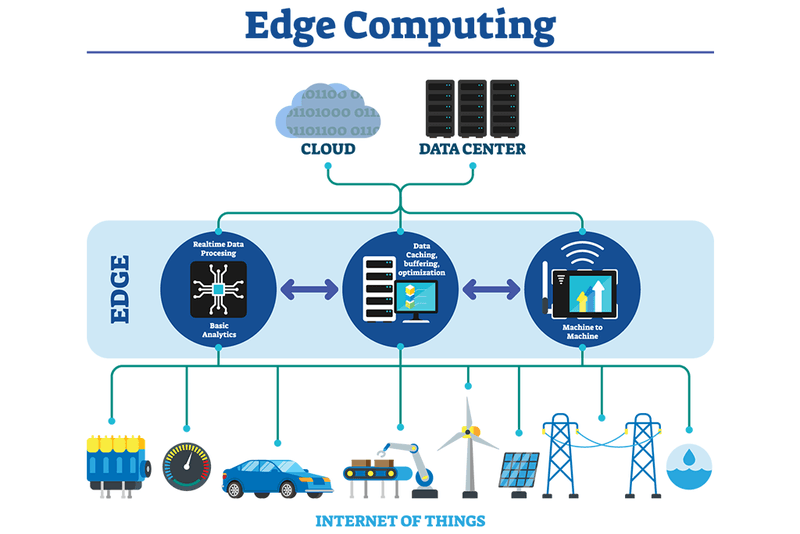
July 1, 2020
What Is Edge Computing And Why It’s Becoming More Significant
Each day, the usage of mobile devices, self-driving vehicles and IoT (Internet of Things) increases. On average, users of these devices will consume upwards of 1.5 gigabytes of data a day in the form of videos, messages, audio files and other media. In order to prepare ourselves for such high rates of data throughput, we must understand the factors that are at play to fully leverage these capabilities. The infrastructure backbone that enables these technologies to emerge has a name — Edge Computing.
Understanding Edge
The main idea behind edge is that content delivery, information processing and topology is placed closer to the user. Think of edge as a decentralized model of computing where data collection and storage is on the device, rather than in the cloud or on a server. In fact, it’s more like bringing the cloud closer to you. Caching data when IoT or mobile devices are in remote locations is crucial for leveraging edge. Managing internet or cellular connectivity and signal strength is essential to using edge to its full potential. Without the ability to provide near real-time updates in data, devices that use edge are unable to accomplish their job in a timely way. There is currently a large demand for edge computing thanks to the exponential rise in IoT devices. For more in-depth data beyond the scope of this article, check out our friends at Gartner who provide detailed insights on a vast range of topics.


Reducing Latency & Expanding Bandwidth
A primary focus in edge computing is reducing latency. One major benefit to upgrading our cellular networks to 5G capability is that it will allow our phones and IoT devices to take advantage of a near 1 millisecond latency. For comparison, using the 4G LTE network, nearly all of our devices have a latency of 20 milliseconds with a much lower bandwidth. When speed matters, 5G performs!
Edge computing also focuses on expanding our usable bandwidth. As video formats such as 4k and 5k make their way to consumer devices, the delivery methods must be optimized to handle such heavy data loads. Your average 5 minute long 60FPS 4k video streamed on YouTube uses approximately 2 gigabytes of bandwidth. Having the infrastructure to handle such data-intensive processes makes edge computing that much more significant over the coming years. Edge brings computation through decentralization closer to the user so that bandwidth and latency are non-issues.
How Edge Computing Is Helping Different Industries
Several Flint Hills Group clients have taken advantage of the latest advancements in edge computing. Our friends at Great Plains Industries use tablets equipped with advanced network capability to talk with water meters and report their output or load new firmware to the meters. The robust bandwidth and low latency powered by edge computing allows this communication to occur quickly. When asked how edge computing has helped a recent client, Jason Dewar of JM Test explained that using edge has allowed his client in a rural area with no sort of network service be able to retrieve data from their oil and gas pumps. The data is then cached on the device retrieving the data. The gauge data is then transferred to the cloud when in cellular range, which allows the “data to be processed faster” using scalable cloud servers. This ultimately helps his client make decisions that help their business. The recent advancements in edge computing have allowed Flint Hills Group to integrate with the test equipment that Jason’s company uses via tablets and mobile applications. The integration allows for our custom software to push the data to the cloud and provide real-time reporting for analysis and record-keeping so Jason and his team can make the right decisions for his company.


The Rise Of 5G
As of December 31st, 2019, the 3G network we were all so accustomed to is no longer relevant. So, what’s new? The 5G network. 5G is the next generation in mobile network technology, promising enhanced speed, responsiveness, and coverage throughout your carrier’s cellular network. Additionally, it boasts enhancements that will lead to low latency performance. These enhancements in speed help our clients in the oil industry leverage the latest advances in computing power using solutions we created specifically for them. One thing is for sure, 5G will meet the expectations of those utilizing the resources that edge computing needs.
Let Us Help
We specialize in building custom solutions crafted around the needs of your business. Our hand-picked, US-based software developers can give your business what it needs to thrive in a fast technology climate. Our team has a diverse skills set that can make your custom software dreams a reality. Browse what Flint Hills Group can provide for your business.
When you choose Flint Hills Group, you choose a dedicated team of experienced US individuals whose focus is delivering a high quality and reliable product. We utilize the latest development trends so that your software is up to date and future ready.
We can provide you with outsourced developers or an entire software team with a project manager. Be sure to read our reviews on Clutch, an independent platform for rating agencies. You can then review our process, and request an estimate for your project.
Chris Gonzalez
Development Enthusiast
Chris is currently a Computer Science student at Western Governors University. He enjoys all aspects of software engineering and web development.




Chris Gonzalez
Development Enthusiast
Chris is a currently a Computer Science student at Western Governors University. He enjoys all aspects of software engineering and web development.

